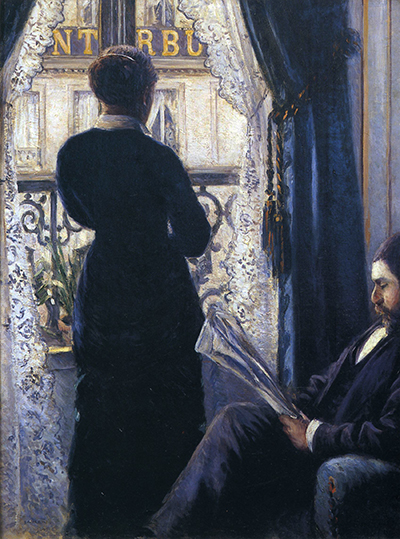Gustave Caillebotte shared many of the ideas of the impressionists, including their use of broad brush strokes to portray perspective, and to convey an original way of looking at subjects, as they might be seen in everyday life. With Interior, Woman at the Window, the man and woman are indoors, in a room where one is sitting, and one is standing. The perspective makes them look as if they are closer together than they really are, and yet they are still isolated in their own separate spaces.
On the very edge of the picture and shown only in profile, the seated figure reads his newspaper, seemingly absorbed in its contents. The woman is preoccupied in her own thoughts, but she is looking down at the boulevard below her. Opposite, at a window of the Hotel Canterbury, another figure peeps through the curtains, observing the woman. The viewer can sense the isolation and loneliness mixed with longing, in a situation where people watch each other and sum them up.
This is a common theme in Caillebotte's work, where balconies, windows and bridges allow subjects to observe and spy on characters going about their everyday lives in Paris. The male figure is said to be Richard Gallo, while the female who shares the room might be a mistress, friend or lodger. Her pose, where she has her back to viewers, had been a common one since seventeenth-century Dutch art, right up to the nineteenth century, and one often used by Caillebotte, but he added another dimension with the inclusion of a second figure.
This oil-on-canvas painting of 1880, now in a private collection, examines the concerns among intellectuals and artists of the time about the coming social, commercial and structural changes in Paris. In this work, Caillebotte cleverly portrays the tensions between the two subjects, employing as he did so often the structures of a window frame and a balcony as metaphorical restrictions, reflecting the new Hausmann city plan.
As he was born in 1848, his early influences naturally came via the impressionists, but Cabillebotte gradually moved beyond this style towards neo-impressionism and realism. His use of cropping, off-centre groupings and back views all give hints of the modernism to come, and of his interest in photography as art.




